Handshake
A handshake is a globally widespread, brief greeting or parting tradition in which two people grasp one of each other's like hands, in most cases accompanied by a brief up-and-down movement of the grasped hands. Using the right hand is generally considered proper etiquette. Customs surrounding handshakes are specific to cultures. Different cultures may be more or less likely to shake hands, or there may be different customs about how or when to shake hands.[1][2][3]
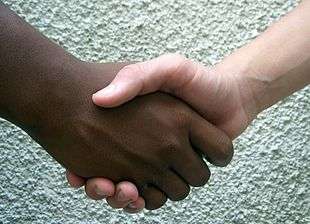
History

One of the earliest known depictions of a handshake is an ancient Assyrian relief of the 9th century BC depicting the Assyrian king Shalmaneser III shaking the hand of the Babylonian king Marduk-zakir-shumi I to seal an alliance.[4]
Archaeological ruins and ancient texts show that handshaking – also known as dexiosis – was practiced in ancient Greece as far back as the 5th century BC; a depiction of two soldiers shaking hands can be found on part of a 5th-century BC funerary stele on display in the Pergamon Museum, Berlin (stele SK1708)[5] and other funerary steles like the one of the 4th century BC which depicts Thraseas and his wife Euandria handshaking.[6] Muslim scholars write that the custom of handshaking was introduced by the people of Yemen.[7]
Gallery

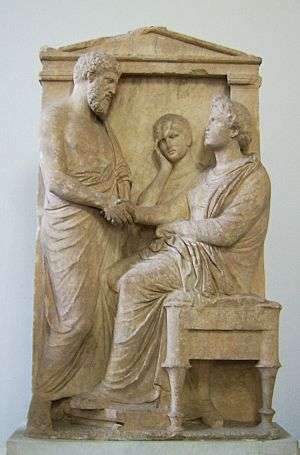 Funerary stele of Thrasea and Euandria. Marble, ca. 375–350 BC. Antikensammlung Berlin, Pergamon Museum, 738
Funerary stele of Thrasea and Euandria. Marble, ca. 375–350 BC. Antikensammlung Berlin, Pergamon Museum, 738
Modern customs

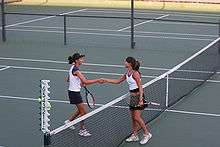

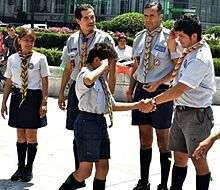
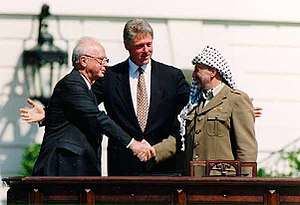
There are various customs surrounding handshakes, both generally and specific to certain cultures:
The handshake is commonly done upon meeting, greeting, parting, offering congratulations, expressing gratitude, or as a public sign of completing a business or diplomatic agreement. In sports or other competitive activities, it is also done as a sign of good sportsmanship. Its purpose is to convey trust, respect, balance, and equality. If it is done to form an agreement, the agreement is not official until the hands are parted.[8]

Unless health issues or local customs dictate otherwise, a handshake is made usually with bare hands. However, it depends on the situation.[10]
- In Anglophone countries, handshaking is common in business situations. In casual non-business situations, men are more likely to shake hands than women.[11]
- In the Netherlands and Belgium, handshakes are done more often, especially on meeting.[12][13]
- In Switzerland, it may be expected to shake the women's hands first.[12]
- Austrians shake hands when meeting, often including with children.[12]
- In the United States a traditional handshake is firm, executed with the right hand, with good posture and eye contact.[12]
- In Russia, a handshake is performed by men and rarely performed by women.
- Hand shaking between men and women is not encouraged in countries such as Saudi Arabia, Iraq, Pakistan, Iran, etc. where the majority religion is Islam. As a general rule, in these countries, men are not allowed to get close to the opposite sex or touch them. Within the Muslim world, Turkey is an exception where men and women can shake hands with each other.
- In some countries such as Turkey or the Arabic-speaking Middle East, handshakes are not as firm as in the West. Consequently, a grip that is too firm is rude.[12] *
- Moroccans also give one kiss on each cheek (to corresponding genders) together with the handshake. Also, in some countries, a variation exists where instead of kisses, and the handshake the palm is then placed on the heart.[14]
- In China, age is considered important in handshake etiquette, and older people should be greeted with a handshake before others.[15] A weak handshake is also preferred, but people shaking hands often hold on to each other's hands for an extended period after the initial handshake.[12]
- In Japan, it is appropriate to let the Japanese initiate the handshake, and a weak handshake is preferred.[12] The Japanese do not have a tradition of shaking hands and prefer to formally bow (with hands open by their sides) to each other, but they will greet non-Japanese with a handshake.
- In India and several nearby countries, the respectful Namaste gesture, sometimes combined with a slight bow, is traditionally used in place of handshakes. However, handshakes are preferred in business and other formal settings.
- In Norway, where a firm handshake is preferred, people will most often shake hands when agreeing on deals, in private and business relations.[12]
- In Korea, a senior person will initiate a handshake, which is preferred to be weak. It is a sign of respect to grasp the right arm with the left hand when shaking hands. It is considered disrespectful to put the free hand in one's pocket while shaking hands.[12][16] Bowing is the preferred and conventional way of greeting a person in Korea.[17]
- Related to a handshake but more casual, some people prefer a fist bump. Typically the fist bump is done with a clenched hand. Only the knuckles of the hand are typically touched to the knuckles of the other person's hand. Like a handshake the fist bump may be used to acknowledge a relationship with another person. However, unlike the formality of a handshake, the fist bump is typically not used to seal a business deal or in formal business settings.
- The hand hug is a type of handshake popular with politicians, as it can present them as being warm, friendly, trustworthy and honest. This type of handshake involves covering the clenched hands with the remaining free hand, creating a sort of "cocoon".[18]
- Another version popular with politicians is a "photo-op handshake" in which, after the initial grasp both individuals turn to face present photographers and camera men and stay this way for several seconds.
- Scouts shake hands with their left hand as a gesture of trust, a practice which originated when the founder of the movement, Lord Baden-Powell of Gilwell, then a British cavalry officer, met an African tribesman.
- In some areas of Africa, handshakes are continually held to show that the conversation is between the two talking. If they are not shaking hands, others are permitted to enter the conversation.
- Masai men in Africa greet one another by a subtle touch of palms of their hands for a very brief moment of time.
- In Liberia, the snap handshake is customary in which the two shakers snap their fingers against each other at the conclusion of the handshake.
- In Ethiopia, it is considered rude to use the left hand during a handshake. While greeting the elderly or a person in authority, it is also customary to accompany the handshake with a bow and the left hand supporting the right. This is especially important if it is the first time.
- In Thailand, handshaking is only done if the traditional wai is not offered. When a person offers a wai, placing their palms together at chest level and bowing. This is then returned, with men saying “Sawadee-krap” and women, saying “Sawadee-kah” (both mean “Hello"). [15]
Germ spreading
Handshakes are known to spread a number of microbial pathogens. Certain diseases such as scabies are known to spread the most through direct skin-to-skin contact. A medical study has found that fist bumps and high fives spread fewer germs than handshakes.[1][2]
In light of the 2009 H1N1 pandemic, the dean of medicine at the University of Calgary, Tomas Feasby, suggested that fist bumps may be a "nice replacement of the handshake" in an effort to prevent transmission of the virus.[3]
Following a 2010 study that showed that only about 40% of doctors and other health care providers complied with hand hygiene rules in hospitals, Mark Sklansky, a doctor at UCLA hospital, decided to test "a handshake-free zone" as a method for limiting the spread of germs and reducing the transmission of disease.[19] However, UCLA did not allow the ban of the handshakes outright, but they rather suggested other options like fist bumping, smiling, bowing, waving, and non-contact Namaste gestures. Other sources suggest raised brows, smiling, wai bow, two claps, hand over heart, sign language wave, or the shaka sign.[20]
During the COVID-19 pandemic, several countries and organisations adopted policies encouraging people to use alternative modes of greeting instead of a handshake.[21] Suggested alternatives have included the elbow bump, the fist bump, foot tapping ("Wuhan Shake")[22] or non-contact actions for social distancing purposes, such as a namaste gesture.[23]
Chemosignaling
It has been discovered as a part of a research in the Weizmann Institute, that human handshakes serve as a means of transferring social chemical signals between the shakers. It appears that there is a tendency to bring the shaken hands to the vicinity of the nose and smell them. They may serve an evolutionary need to learn about the person whose hand was shaken, replacing a more overt sniffing behavior, as is common among animals and in certain human cultures (such as Tuvalu, Greenland or rural Mongolia, where a quick sniff is part of the traditional greeting ritual). [24]
World records
In 1963, Lance Dowson shook 12,500 individuals' hands in 10 1⁄2 hours, in Wrexham, N. Wales. Atlantic City, New Jersey Mayor Joseph Lazarow was recognized by the Guinness Book of World Records for a July 1977 publicity stunt, in which the mayor shook more than 11,000 hands in a single day, breaking the record previously held by President Theodore Roosevelt, who had set the record with 8,510 handshakes at a White House reception on 1 January 1907. Dowson's record was recognised by the Guinness World Records Organisation and published in their 1964 publication. On 31 August 1987, Stephen Potter from St Albans shook 19,550 hands at the St Albans Carnival to take the world record for shaking most hands verified by the Guinness Book of World Records. The record has since been exceeded but has been retired from the book. Potter still holds the British and European record.
On 15 August 2008 Kirk Williamson and Richard McCulley broke the Guinness World Record for the World's Longest Handshake (single hand) when they met at Aloha Stadium in Honolulu, Hawaii and shook hands for 10 hours, besting the previous record of 9 hours and 19 minutes set in 2006.[25] On 21 September 2009, Jack Tsonis and Lindsay Morrison then broke that record by shaking hands for 12 hours, 34 minutes and 56 seconds.[26] Their record was broken less than a month later in Claremont, California, when John-Clark Levin and George Posner shook hands for 15 hours, 15 minutes, and 15 seconds. The next month, on 21 November, Matthew Rosen and Joe Ackerman surpassed this feat, with a new world record time of 15 hours, 30 minutes and 45 seconds[27] certified in an edition of the Guinness Book of Records on page 111.
At 8 p.m. EST on Friday 14 January 2011 a new attempt at the longest hand-shake commenced in New York Times Square and the existing record was broken[28] by semi-professional world record-breaker Alastair Galpin[29][30] and Don Purdon from New Zealand and Nepalese brothers Rohit and Santosh Timilsina who agreed to share the new record after 33 hours and 3 minutes.
On 29 January 2020, a new world record for the longest handshaking relay was set by approximately 1,817 people in Abu Dhabi, United Arab Emirates at Umm Al Emarat Park in an event organized by the Abu Dhabi Police to celebrate the 1 year anniversary of the signing of the Document on Human Fraternity for World Peace and Living Together in the city.[31]
See also
- Dap greeting
- Fist bump
- Namaste
- Golden handshake
- Greeting habits
- Handshake Man
- Holding hands
- Scout handshake
- Secret handshake
- Transmission (medicine)
References
- "Fist bumps, high-fives spread fewer germs than handshakes, study says". Los Angeles Times. 28 July 2014. Retrieved 7 June 2015.
- "Attention Germaphobes: A Less Icky Alternative to the Handshake". ABC News. Retrieved 7 June 2015.
- Fist bump can pound out flu transmission Archived 20 January 2011 at the Wayback Machine
- Andrews, Evan. "The History of the Handshake". HISTORY. Retrieved 18 July 2020.
- Thomas, Chris (27 August 2009). "Handshake – Priest and two soldiers, 500BC. Pergamon Museum Berlin (SK1708)". Picasa Web Albums. Retrieved 4 September 2011.
- Busterson, Philip A. Social Rituals of the British.
- IslamKotob. Riyad-us-Saliheen. IslamKotob.
- "Shaking hands with women". GQ. Condé Nast Digital. 2000. Retrieved 4 September 2011.
- [https://kansallisbiografia.fi/kansallisbiografia/henkilo/628 Relander, Lauri Kristian (1883 - 1942) – Kansallisbiografia]
- Post, Emily (1922). Etiquette in Society, in Business, in Politics and at Home. New York: Funk & Wagnalls. Chapter 3.
- "Why Do People Shake Hands? | Why Do People". whydopeople.net. 2012. Retrieved 21 May 2012.
- "Whoops! > The Connected Woman Association".
- "Shaking Hands Around the World". wisc-online.com. 2012. Retrieved 21 May 2012.
- Strubbe, Kevin; Hobert, Liesbeth (2009). Etiquette in het buitenland [Etiquette Abroad] (in Dutch). Leuven: Van Halewyck. ISBN 978-90-5617-910-6.
- "What is Proper Handshake Etiquette Around the World?". www.mentalfloss.com. 5 December 2013. Retrieved 28 March 2020.
- "Bill Gates' Handshake With South Korea's Park Sparks Debate". NPR.org.
- "Understanding South Korean Business Etiquette". 22 March 2018.
- Handshake: Student's Book: A Course in Communication. OUP Oxford. 7 November 1996. ISBN 978-90-5617-910-6.
- "Handshake-Free Zone: Stopping the Spread of Germs in the Hospital". Medscape.
- Stop shaking hands. Do this instead, Scottie Andrew, CNN Travel, 17 April 2020. https://www.cnn.com/travel/article/handshake-alternatives-gestures-around-world-trnd/index.html
- BBC News, Coronavirus: Dutch PM tells nation not to shake hands – then does, published 10 March 2020, accessed 14 March 2020
- BBC News, Coronavirus: The 'Wuhan shake' or the elbow bump?, published 3 March 2020, accessed 17 May 2020
- Noguchi, Yuki (12 March 2020). "Nice To Meet You, But How To Greet You? #NoHandshake Leaves Businesspeople Hanging". NPR. Retrieved 16 March 2020.
- Idan Frumin; Ofer Perl; Yaara Endevelt-Shapira; Ami Eisen; Neetai Eshel; Iris Heller; Maya Shemesh; Aharon Ravia; Lee Sela; Anat Arzi; Noam Sobel (3 March 2015). "A social chemosignaling function for human handshaking". eLife. 4. doi:10.7554/eLife.05154. PMC 4345842. PMID 25732039.
- NCTAMSPAC Public Affairs Office (Fall 2008). "Sailor & Coast Guardsman Go for World Record Handshake for Charity Event" (PDF). Info Domain. Retrieved 31 January 2009.
- McClymont, Mhairi (21 September 2009). "Great shakes! World record raises charity funds". ABC News. Retrieved 9 September 2011.
- "Movers and shakers – an article on the new World Record". The Jewish Chronicle. 3 December 2009. Retrieved 9 September 2011.
- "Longest Handshake: Team New Zealand and Team Nepal set world record". New York City: Worldrecordsacademy.org. 18 January 2011. Retrieved 4 September 2011.
- Galpin, Alastair. "Records achieved". WorldRecordChase.com. Longest continuous handshake. Retrieved 4 September 2011.
- "Kiwis break world record for a handshake". Television New Zealand Limited. 17 January 2011. Retrieved 9 September 2011.
- Kumar, Ashwani. "Video: 'Human chain of love' in UAE sets world record". Khaleej Times. Retrieved 31 January 2020.
External links



- http://www.videacesky.cz/ostatni-zabavna-videa/gesta-napric-kulturami